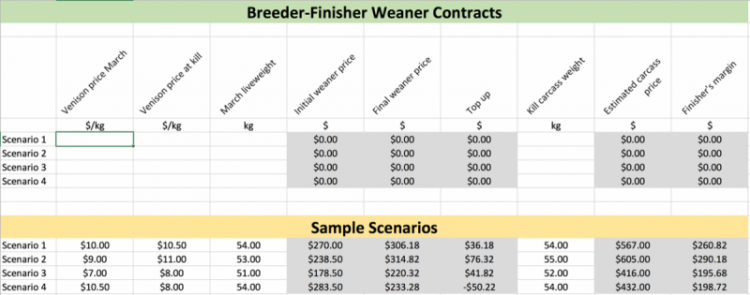How it works
- The base price for weaners is initially set at 50% of the current venison schedule at the time of selling (March).
- This figure is multiplied by the weaner liveweight and the total comprises the first part payment.
- Under normal conditions the first part payment would comprise at least three-quarters of the total paid, but this can vary.
- Breeder and finisher agree as to when the deer will be killed (say November and December).
- When known, the average of the venison schedule is taken for November and December.
- This is multiplied by 54% (the average carcass yield), multiplied by the original average liveweight of the weaner.
- This figure is now the total price paid per weaner.
- The original payment is then subtracted from the final value to give the second, or top up payment to the breeder. (In rare circumstances, especially if the venison schedule falls during the year, this may yield a negative value, which is recorded as a credit to the finisher.)
A step-by-step guide
This example uses Scenario 3 below.
Step 1: Find a breeder or finisher to work with.
Step 2: A contract between breeder and finisher is drawn up. Base price for weaners is set at 50% of the current venison schedule at the time of selling in March (e.g. 50% of $7.00 = $3.50) multiplied by the weaner liveweight (e.g. 51kg). Example: 51kg x $3.50 = $178.50
This is the breeder’s first part payment and comprises 81 percent of the total payment.
Step 3: It is then agreed as to when the deer will be killed (say November and December).
Step 4: When known, the average of the venison schedule for November and December is calculated ($8.00 in our scenario). Multiply by 54% (the average carcass yield), then multiply by the original average liveweight of the weaner (51kg). Example: $8.00 x 54% x 51kg = $220.32
This figure ($220.32) is now the total price paid per weaner.
We now take the initial weaner price of $178.50 and subtract it from the final value ($220.32) to give the second, or top up payment of $41.82.
Example: $220.32 – $178.50 = $41.82 (to be paid out as second payment, or ‘top-up’)
Additions
Elements to the contract other than price can be added to suit each unique business relationship, for example:
- Defining when ownership of the stock transfers from breeder to finisher, e.g. “The breeder must take responsibility for any weaner deaths that occur within 72 hours of their departure from the property.”
- Animal health requirements, e.g. “All stock to be Yersiniavaxed in line with label recommendations 2 weeks before transporting to finishing property.”
We’ve made it easy!
The simple spreadsheet below can be used to enter values for schedule price, liveweight and carcass weight to calculate the payments and margins. Samples are also included to show how this can work under different price and weight scenarios.
To download a copy of the below spreadsheet, click here >>

Deer Industry New Zealand has sought the information displayed above from deer producers involved in such contracts and this information has been published with their prior agreement. DINZ advises that legal advice be sought before entering into any binding agreement

